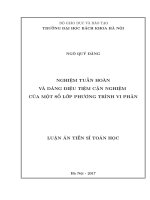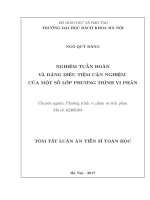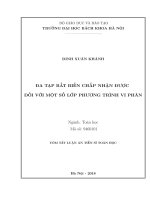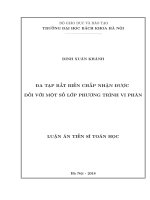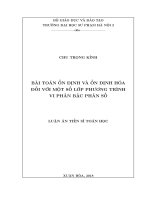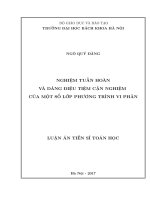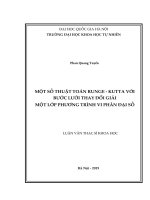Nghiệm đại số của một số lớp phương trình vi phân đại số cấp một TT TIENG ANH
Bạn đang xem bản rút gọn của tài liệu. Xem và tải ngay bản đầy đủ của tài liệu tại đây (317.89 KB, 29 trang )
MINISTRY OF EDUCATION AND TRAINING
QUY NHON UNIVERSITY
HA TRONG THI
ALGEBRAIC SOLUTIONS OF SOME CLASSES OF
FIRST-ORDER ALGEBRAIC ORDINARY
DIFFERENTIAL EQUATIONS
SUMMARY OF
DOCTORAL THESIS IN MATHEMATICS
Binh Dinh - 2021
MINISTRY OF EDUCATION AND TRAINING
QUY NHON UNIVERSITY
HA TRONG THI
ALGEBRAIC SOLUTIONS OF SOME CLASSES OF
FIRST-ORDER ALGEBRAIC ORDINARY
DIFFERENTIAL EQUATIONS
Speciality :
Algebra and Number Theory
Code
9460104
:
Reviewer 1 :
Prof. Dr.Sc. Phung Ho Hai
Reviewer 2 :
Ass. Prof. Dr. Truong Cong Quynh
Reviewer 3 :
Ass. Prof. Dr. Mai Hoang Bien
Supervisors:
DR. NGO LAM XUAN CHAU
DR. LE THANH HIEU
Binh Dinh - 2021
i
Declaration
This thesis was completed at the Department of Mathematics and Staticstics, Quy Nhon University, under the supervision of Dr. Ngo Lam Xuan
Chau and Dr. Le Thanh Hieu. I hereby declare that the results presented in
this thesis are new and original. Most of them were published in peer-reviewed
journals, and others have not been published elsewhere. For using results from
joint papers I have gotten permissions from my co-authors.
Quy Nhon, 02 November, 2021
Author
Ha Trong Thi
ii
Acknowledgments
iii
Contents
Preface
1
1 Preliminary
4
1.1
Background on algebra . . . . . . . . . . . . . . . . . . . . . .
4
1.2
Differential algebra . . . . . . . . . . . . . . . . . . . . . . . .
4
1.3
Rational algebraic curves . . . . . . . . . . . . . . . . . . . . .
4
2 Equivalence transformations on first-order AODEs
5
2.1
Equivalence transformations . . . . . . . . . . . . . . . . . . .
5
2.2
Măobius transformations
6
. . . . . . . . . . . . . . . . . . . . .
3 Algebraic solutions of first-order algebraic ordinary differential equations
8
3.1
Algebraic solutions . . . . . . . . . . . . . . . . . . . . . . . .
8
3.2
The existence of the solutions under group transformations . .
9
3.3
A degree bound for algebraic general solutions . . . . . . . . .
10
4 The equivalence of rationally parametrizable first-order algebraic ordinary differential equations
11
4.1
11
Polynomial ordinary differential equations . . . . . . . . . . .
4.1.1
Differential invariant under the transformation y = z + b 11
4.1.2
Differential invariant under the transformation z = aw
4.1.3
Differential invariant under the transformation y = aw + b 12
12
4.2
Riccati differential equations
. . . . . . . . . . . . . . . . . .
12
4.3
Abel’s differential equations . . . . . . . . . . . . . . . . . . .
13
iv
4.4
Rationally parametrizable first-order algebraic ordinary differential equations . . . . . . . . . . . . . . . . . . . . . . . . . .
4.5
15
Algebraic general solutions of autonomous rationally parametrizable differential equations . . . . . . . . . . . . . . . . . . . .
17
Conclusion
19
List of author’s papers related to the thesis
20
REFERENCES
21
1
PREFACE
A first-order algebraic ordinary differential equation (shortly, first-order
AODE ) over C(x) is of the form
F (y, y ) = 0,
where F ∈ C(x)[y, y ] effectively contains the derivative y . If F ∈ C[y, y ],
then we say the equation F (y, y ) = 0 is autonomous (i.e. all coefficients of F
are constants).
First-order AODEs have been studied since the late nineteenth century and
early twentieth century by the works of L. Fuchs [14], H. Poincar´e [27] and
∂
F (y, y ) = 0
J. Malmquist [19]. A common solution of F (y, y ) = 0 and
∂y
is called a singular solution. Singular solutions of F (y, y ) = 0 are always
algebraic solutions, and there are finitely many singular solutions. Although
these singular solutions are easily computed, determining whether the equation F (y, y ) = 0 has algebraic general solutions or not and finding an algorithm for computing an algebraic general solution are difficult problems.
The works in [22, 23] use Măobius transformations to show that there is
a class of non-autonomous first-order AODEs which are equivalent to autonomous one having algebraic general solutions. The theoretical study on
this problem is hence reasonable.
In addition, based on a degree bound of non-trivial algebraic solutions
of a first-order autonomous algebraic ordinary differential equation, we can
2
deduce a degree bound for the algebraic general solution. Extending this to
non-autonomous AODEs is an open question that needs to be solved.
A solution of the first-order algebraic ordinary differential equation F (y, y ) =
0 in a differential field extension K of C(x) is an element η ∈ K such that
F (η, η ) = 0, where “ ” is the derivation of K extending the usual derivation
of C(x). If F is of degree one in y , then the differential equation F (y, y ) = 0 is
usually written in the rational form y = P (x, y)/Q(x, y), where P and Q are
relatively prime polynomials in two variables. The well-known Poincar´e problem is finding a degree bound for algebraic solutions of this rational differential
equation. In 1994, Carnicer [4] solved this problem in the non-dicritical case.
In 1998, Eremenko [12] showed that there is an effective degree bound for rational solutions of the differential equation F (y, y ) = 0 and it is a challenging
question whether this work can be extended to algebraic solutions.
More recently, Feng et al. [13, 2] have provided a degree bound for algebraic
general solution of autonomous AODEs of order one. In addition, computing
an algebraic general solution of these equations amounts to computing a nontrivial algebraic solution. Computing explicit rational solutions and algebraic
solutions of non-autonomous first-order AODEs has been attracting domestic
and oversea mathematicians during the past few years. The approach of R.
Feng and X-S. Gao [13] in the autonomous case can be extended in a natural
way to parametrizable non-autonomous class in several papers of L. X. C. Ngo
and F. Winkler [22, 25, 26]. These problems were more completely studied
in N. T. Vo’s Ph.D thesis [34] with new algorithms for computing rational
solutions of these equations.
Apart from solving first-order AODEs, classifying the equivalences of such
equations is also of interest. In [23, 24, 21], the authors have provided different equivalence relations on first-order AODEs. According to this, solving
an algebraic ordinary differential equation can amount to one in the same
equivalence class. Another question is to classify equations concerning such
equivalence relations.
3
This thesis aims to seek some classes of first-order AODEs, in which we can
determine whether an algebraic general solution exists. In case such a solution
exists, we provide an algorithm to compute this solution. In particular, the
thesis focuses on studying the existence and computing an algebraic general
solution of first-order AODEs, which is equivalent to an autonomous equation
and rationally parametrizable algebraic ordinary differential equation.
Apart from Preface, Conclusion, List of notation, References, List of the
author’s publications, this thesis consists of four chapters:
Chapter 1 presents some basic notions and results which will be used in
the latter chapters, including basic results in algebra, differential algebra, and
rational algebraic curves.
Chapter 2 gives a brief overview of equivalence transformations on AODEs
of order one and studies the equivalence transformation with respect to a
Măobius transformation. We provide an invariant property of the differential
total degree of AODEs of order one.
Chapter 3 provides some properties of the solutions of AODEs which are
invariant under the group actions of Măobius transformations. In particular,
algebraic general solutions are preserved. Associated with the invariant property of differential total degree, we give a degree bound for AODEs of order
one in an autonomous class. Then we propose an algorithm to compute algebraic general solutions of different equations in the autonomous equivalence
class.
Chapter 4 gives a criterion for the equivalence of polynomial differential
equations in the form y = P (x, y). As a consequence, we propose an algorithm to check whether two first-order algebraic differential equations that
are rationally parametrizable are in the same equivalence class. Finally, we
offer another algorithm for computing algebraic general solutions of first-order
AODEs that are rationally parametrizable and in an autonomous equivalence
class.
4
Chapter 1
Preliminary
1.1
Background on algebra
This section lists some basic notions in the field of algebra, which are referred from [18, 8].
1.2
Differential algebra
In this section, we present a background on differential rings, differential
fields, and differential ideals. These concepts are used to construct the notions
of general solution, singular solution of differential equations. The content of
this section is followed from [30, 16, 3].
1.3
Rational algebraic curves
This section is devoted to present some basic notions and important results
in the theory of algebraic curves, which will be used in Chapter 4. The main
content of this part is referred to [32].
5
Chapter 2
Equivalence transformations on
first-order AODEs
Some results in this chapter are published in [6].
2.1
Equivalence transformations
The work by F. Schwarz [31] introduces the definitions of structure invariance group, absolute invariants, rational normal forms for ordinary differential
equations of arbitrary order. We present these notions for first-order AODEs.
Proposition 2.1. The set of all Riccati differential equations
y = a2 (x)y 2 + a1 (x)y + a0 (x),
where ai ∈ C(x) for all i = 0, 1, 2, is closed under the transformations
x = t,
y=
a(t)u + b(t)
,
c(t)u + d(t)
with a, b, c, d ∈ C(t) and ad − bc = 0.
Proposition 2.2. The set of all Abel’s differential equations of the first and
second kind, respectively,
3
2
y = a3 y + a2 y + a1 y + a0 ,
a3 y 3 + a2 y 2 + a1 y + a0
y =
y + b0
are closed under the transformations
x = t,
y=
with a, b, c, d ∈ C(t) and ad − bc = 0.
a(t)u + b(t)
,
c(t)u + d(t)
6
Definition 2.3. Let F (x, y, y ) = 0 be an algebraic ordinary differential equation with coefficients a1 , . . . , aN depending on x. Let a
˜1 , . . . , a
˜N be the coefficients of the transformed equations under a given transformation. An expression Φ satisfying
Φ(˜
a1 , . . . , a
˜N ) = Φ(a1 , . . . , aN )
is called an invariant of the differential equation F (x, y, y ) = 0.
Definition 2.4. A rational normal form of an algebraic ordinary differential equation is an equation obtained from the original equation by a transformation of dependent and independent variables with the least number of
non-constant coefficients.
2.2
Mă
obius transformations
(1)
We denote by AODE K = {F (y, y ) = 0 | F ∈ K[y, w]} the set of all firstorder AODEs on K. A Măobius transformation on K is a rational function of
the form
au + b
,
cu + d
where a, b, c, d ∈ K and ad − bc = 0. Define
M (u) =
∂M (u) (a u + b )(cu + d) − (au + b)(c u + d )
=
∂x
(cu + d)2
Au2 + Bu + C
=
, 0 ≤ degu (Au2 + Bu + C) ≤ 2,
2
(cu + d)
where A = a c − ac , B = a d − ad + b c − bc , C = b d − bd and
ad − bc
∂M (u)
=
.
∂u
(cu + d)2
a
Note that A = 0 if c = 0 or is constant.
c
For each M (u), we define a rational map ΦM : K 2
ΦM (u, v) = M (u),
K 2 by
∂M (u) ∂M (u)
+
v .
∂x
∂u
It is worth mentioning that the identity map Φ(u, v) = (u, v) is rational with
respect to M (u) = u; ΦM is a birational map and its inverse is also birational
7
associated with M −1 (u) =
du − b
, that is Φ−1
M (u, v) =
−cu + a
−1
M −1 (u), ∂M∂x (u) +
∂M −1 (u)
v
∂u
.
We have the following result.
(1)
Proposition 2.5. The set GK consists of all rational transformations of the
form ΦM is a group with function composition. This group is isomorphic to
that of Mă
obius transformations on K.
(1)
Definition 2.6 (Differential total degree of F ). Let F ∈ AODE K and
F (y, y ) = A0 y m + A1 y m−1 + · · · + Am−1 y + Am ,
where m ∈ N∗ , Ai ∈ K[y] for all i = 0, . . . , m, A0 = 0. The number
δF := max{2(m − i) + degy Ai | i = 0, . . . , m}
is called the differential total degree of F .
(1)
Proposition 2.7. Let F, G ∈ AODE K be different from zero. Then
δF ·G = δF + δG .
(1)
(1)
Definition 2.8. The action of group GK on AODE K is defined by
ΦM • F = (−cy + a)δF (F (ΦM −1 (y, y ))),
au + b
(1)
(1)
for every ΦM ∈ GK defined by M (u) =
and for every F ∈ AODE K .
cu + d
Proposition 2.9. We have
1. ΦM • (ΦN • F ) = ΦM ◦N • F ;
2. ΦM • (F · G) = (ΦM • F ) · (ΦM • G).
(1)
Definition 2.10. Let F, G ∈ AODE K . We say that F is equivalent to G,
(1)
denoted by F ∼ G, if there is ΦM ∈ GK such that ΦM • F = G.
Theorem 2.11. Let F (y, y ) = A0 y m + · · · + Am−1 y + Am ∈ K[y, y ], A0 = 0
(1)
and G = ΦM • F , where ΦM ∈ GK . Let δF be the differential total degree of
F . Then
(1) degy G = degy F,
(2) degy G ≤ δF ,
(3)δG = δF .
8
Chapter 3
Algebraic solutions of first-order
algebraic ordinary differential
equations
3.1
Algebraic solutions
Definition 3.1. Let K be a differential field and F ∈ K{y} is a differential
polynomial. An algebraic solution of F = 0 on K is a solution of F which is
an algebraic element on K.
Proposition 3.2. If F ∈ K{y} is an irreducible differential polynomial of
order one, then every singular solution of F (y, y ) = 0 is an algebraic solution.
In addition, the number of singular solutions of F (y, y ) = 0 is finite.
Proposition 3.3. Let P (y) be the minimal polynomial of an algebraic solution
η ∈ L of F (y, y ) = 0 on K. Then, all ξ ∈ L such that P (ξ) = 0 are algebraic
solutions of F (y, y ) = 0.
Definition 3.4 ([2]). An algebraic solution P (x, y) = 0 of the autonomous
algebraic ordinary differential equation of order one F (y, y ) = 0 is called
non-trivial if degx P > 0.
Proposition 3.5 ([2]). Let F ∈ C{y} be an irreducible autonomous differential polynomial of order one. Suppose that P (x, y) = 0 is a non-trivial algebraic
solution of F (y, y ) = 0. Then P (x + C, y) = 0 is an algebraic general solution
of F (y, y ) = 0, where C is an arbitrary constant.
9
Theorem 3.6 ([2]). Let F ∈ Q[y, y ] be an irreducible polynomial on Q. Suppose that P ∈ Q[x, y] is irreducible and P (x, y) = 0 is a non-trivial algebraic
solution of the autonomous differential equation F (y, y ) = 0. Then
degy P ≤ degy F + degy F.
degx P = degy F,
Furthermore, P (x + c, y) = 0 is an algebraic general solution of F (y, y ) =
0 and this degree bound is fine, i.e. there exists an autonomous equation
F (y, y ) = 0 such that the equality occurs in the above degree bound.
3.2
The existence of the solutions under group transformations
(1)
Theorem 3.7. Let F, G ∈ AODE K and suppose that F ∼ G. Then F has
an algebraic general solution if and only if so does G.
Definition 3.8. For a constant c ∈ C, we define the translation map
(1)
(1)
Tc : AODE K → AODE K
(1)
defined by Tc F = F (x + c, y, y ) for all F ∈ AODE K .
(1)
Proposition 3.9. F ∈ AODE K is autonomous if and only if Tc F = F for
all c ∈ C.
(1)
Definition 3.10. Let F ∈ AODE K be autonomous and ΦM be a transformation such that ΦM • F is autonomous. An algebraic solution P (x, y) = 0
of F (y, y ) = 0 over C(x) is said to be non-trivial with respect to ΦM if
degx (ΦM • P ) > 0.
Theorem 3.11. Let F (y, y ) = 0 be a first-order algebraic ordinary differential
equation which is autonomous, and ΦM be a transformation such that ΦM •F =
0 is autonomous. Suppose that P (x, y) = 0 is a non-trivial algebraic solution
of F (y, y ) = 0 over C(x) with respect to ΦM . Then ΦM −1 • (TC (ΦM • P )) = 0
is an algebraic general solution of F (y, y ) = 0 for an arbitrary constant C.
10
Theorem 3.12. Suppose that F (y, y ) = 0 is in the autonomous class and
P (x, y) = 0 is a non-trivial algebraic solution of F (y, y ) = 0 with respect to
ΦM . Then the genus of the algebraic curve P (x, y) = 0 is the same as the
genus of the algebraic curve F (y, y ) = 0.
3.3
A degree bound for algebraic general solutions
(1)
(1)
Theorem 3.13. Let F ∈ AODE K and suppose that there exists ΦM ∈ GK
such that ΦM • F is an autonomous AODE. Then the total degree of an algebraic general solution of F (y, y ) = 0 over K is bounded above by (δF +degy F ).
ay + b
and that the degrees of a, b, c, d are
In addition, suppose that M (y) =
cy + d
less than N . Then the minimal polynomial of the algebraic general solution of
F (y, y ) = 0 has the degree in x less than degy F + N (δF + degy F ).
Algorithm 1
Input: F ∈ K[y, y ], degy F > 0, degy F > 0, M (y) =
ΦM • F is autonomous.
ay + b
such that
cy + d
Output: Compute an algebraic general solution of F = 0 if exists.
1. Applying Algorithm 4.4 in [2] to compute a non-trivial algebraic solution
of ΦM • F . If NOT exist, RETURN “F = 0 has no algebraic general
solution”. Else, go to step 2.
2. Let Q(z, y) = 0 be the non-trivial algebraic solution of ΦM • F = 0.
RETURN
(−cy + a)degy Q Q(z + C, M −1 (y)) = 0
is an algebraic general solution of F = 0 for arbitrary constant C.
11
Chapter 4
The equivalence of rationally
parametrizable first-order algebraic
ordinary differential equations
4.1
Polynomial ordinary differential equations
A polynomial ordinary differential equation is in the form
y = an (x)y n + an−1 (x)y n−1 + · · · + a1 (x)y + a0 (x),
(4.1)
where a0 , a1 , . . . , an ∈ K, an = 0.
4.1.1
Differential invariant under the transformation y = z + b
Equation (4.1) is transformed to
z = An (x)z n + An−1 (x)z n−1 + · · · + A1 (x)z + A0 (x),
(4.2)
Theorem 4.1. For 2 ≤ i ≤ n − 1, we have
i−1
An−i = −
(−1)
j=0
i−j
n−j
i−j
ni−j
i−j
An−1
An−j
+
ani−j
i−1
i−j
(−1)
j=0
n−j
i−j
ni−j
i−j
an−1
an−j
+ an−i . (4.3)
ani−j
Theorem 4.2. We have
n
j=0
(−1)j Aj Ajn−1
An−1
+
j
j
n
nAn
An
n
=
j=0
(−1)j aj ajn−1
an−1
+
j
j
n
nan
an
.
12
4.1.2
Differential invariant under the transformation z = aw
Equation (4.2) is transformed to
w =a
˜n (x)wn + a
˜n−1 (x)wn−1 + · · · + a
˜1 (x)w + a
˜0 (x),
(4.4)
By eliminating a, we obtain the following invariants
a
˜i
Ai
i−1 =
i−1 ,
n−1
n−1
˜n
An
a
1
∀i = 2, . . . , n − 1,
a
˜n
1
An
a
˜1 +
= A1 +
,
n
−
1
a
˜
n
−
1
A
n
n
1
1
a
˜0 a
˜nn−1 = A0 Ann−1 .
(4.5)
Remark 4.3. In order to transform equation (4.2) to (4.4) under z = aw, a
must be defined by a
˜n = An an−1 . In general, a is in an algebraic extension of
the field containing coefficients a
˜n and An .
4.1.3
Differential invariant under the transformation y = aw + b
Theorem 4.4. For n ≥ 3, two polynomial ordinary differential equations (4.1)
and (4.4) are equivalent under the transformation y = aw + b if and only if
Ki (a) = Ki (˜
a),
2 ≤ i ≤ n − 2,
K1 (a) = K1 (˜
a),
K (a) = K (˜
a).
0
(4.6)
0
Corollary 4.5. For n ≥ 3, polynomial differential equation (4.1) is equivalent
to the following normal form
u = un + Kn−2 (a)un−2 + · · · + K1 (a)u + K0 (a)
an−1
1
.
under the transformation y = α1 u + β1 with α1n−1 = , β1 = −
an
nan
4.2
Riccati differential equations
Theorem 4.6. For n = 2, two Riccati differential equations (4.1) and (4.4)
˜ 0 (a) =
are equivalent under the transformation y = aw + b if and only if K
˜ 0 (˜
K
a).
13
Example 4.7. Two Kamke’s differential equations (see [15])
2
4
no.1.140 : y = −y 2 − y − 2 , and
x
x
1
4x + 1
4
no.1.165 : y = − 2
y2 + 2
y−
2x − x
2x − x
2x − 1
˜ 0 (a) = 0 under
are equivalent since they have the same differential invariant K
1
4x − 1
the transformation y = aw + b, where a = 2
,b=− 2
.
2x − x
2x − x
Remark 4.8. In [9], Czy˙zycki and collaborators studied the equivalence of the
Riccati differential equations under the action of some subgroups of the Lie
group of equivalent transformations of Riccati differential equations, including
the transformation y = aw + b.
Proposition 4.9. The Riccati differential equation is equivalent to the autonomous differential equation under the transformation y = aw + b if and
˜ 0 (a) is constant.
only if the differential invariant K
˜ 0 (a) is non-constant and the Riccati differential equation is defined on
If K
C(x), then we can use the algorithm by Kovacic (J. Kovacic 1986, [17]) to
compute algebraic solutions of Riccati differential equation.
Remark 4.10. Based on the classification of Galois differential groups of
second order linear differential equations, F. Ulmer et al. [33, Corollary 1.7]
provided possible degrees of the minimal polynomials of algebraic solutions of
the Riccati differential equation w = w2 + r(x).
Remark 4.11. Regarding the coefficients of minimal polynomials of algebraic
solution, A. Zharkov (1995) [35, Theorem 1.1] showed that if the Riccati equation w + w2 = r, for r ∈ Q(x), has an algebraic solution, then there exists
a minimal polynomial of that solution whose coefficients are all in a field
extension of Q with the degree at most 3.
4.3
Abel’s differential equations
Abel’s differential equation of the first type is of the form
y = a3 y 3 + a2 y 2 + a1 y + a0 ,
(4.7)
14
where ai ∈ K. Abel’s differential equation of the second type
a3 y 3 + a2 y 2 + a1 y + a0
,
y =
b1 y + b0
1
can be transformed to the first type (4.7) by the transformation b1 y + b0 = .
v
Under the transformation y = aw + b, Abel’s equation (4.7) is transformed
to w = a
˜3 w 3 + a
˜2 w 2 + a
˜1 w + a
˜0 .
Corollary 4.12. The system of basic differential invariants of Abel’s equation
is
1 a3 1 a22
−
,
K1 (a) = a1 +
K0 (a) =
1
2 a3
3 a3
2 3
2
(3a
a
−
a
a
a
+
a
a
−
a
a
+
a ).
0
1
2
3
3
2
3
2
3
3/2
9 2
3a3
(4.8)
Corollary 4.13. Two Abel’s differential equations y = a3 y 3 + a2 y 2 + a1 y + a0
and w = a
˜3 w 3 + a
˜2 w 2 + a
˜1 w + a
˜0 are equivalent under the transformation
y = aw + b if and only if K1 (a) = K1 (˜
a) and
K0 (a) = K0 (˜
a).
Example 4.14. Two Abel’s differential equations
dt
= − (t + x − 1)((t + x)2 − 5(t + x) + 7)
dx
(4.9)
and
ds
= −(s − 1)3 .
dx
are equivalent under the transformation t = s − x + 1.
(4.10)
Theorem 4.15. We can transform Abel’s differential equation to the following
normal form
w = w3 + K1 (a)w + K0 (a).
(4.11)
Remark 4.16. If both K0 (a) and K2 (a) are constant, then Abel’s differential
equation is equivalent to an autonomous differential equation.
Remark 4.17. If K0 (a) = 0 then equation (4.11) is Bernoulli’s differential
equation.
Theorem 4.18. There are different normal forms of Abel’s differential equations:
15
1. w = a
˜3 w 3 + a
˜1 w, if K0 (˜
a) = 0;
2. w = a
˜3 w 3 + a
˜1 w + 1, if K0 (˜
a) = 0.
Remark 4.19. By using transformations of the form x = φ(t), y(x) = a(t)w(t)+
b(t), P. Appell [1] transformed a normal form of Abel’s differential equation
w = w3 + J(t) and J(t) is an invariant of the transformation. The equivalence of two Abel’s differential equations under the above transformations was
studied by E. S. Cheb-Terrab et al. [7].
4.4
Rationally parametrizable first-order algebraic ordinary differential equations
Definition 4.20. A first-order algebraic ordinary differential equation F (y, y ) =
0 on C(x) is called rationally parametrizable if the corresponding algebraic
curve F (y, y1 ) = 0 is rational.
Definition 4.21. The associated differential equation of F (y, y ) = 0, with
respect to P(t) = (u(t), v(t)), is
v(t, x) − ∂u(t,x)
dt
∂x
=
.
∂u(t,x)
dx
∂t
(4.12)
The problem of determining degree bound for invariant algebraic curves
is known as “Poincar´e’s problem”. In [4], Carnicer solved this problem in
the non-dicritical case. If a degree bound for invariant algebraic curves is
obtained, then the differential equation has an algebraic general solution, and
one can compute it in the affirmative case using the Prelle-Singer procedure
in[28, 20].
Theorem 4.22. Let G = ΦM • F . Suppose that P(t) = (u(t), v(t)) is a
properly rational parametrization of F (y, y1 ) = 0 and let Q(t) = ΦM (P(t)).
Then G(w, w1 ) = 0 is rationally parameterized by Q(t) and the associated
differential equation of G(w, w ) = 0 with respect to Q(t) is the associated
differential equation of F (y, y ) = 0 with respect to the rational parametrization
P(t).
16
Theorem 4.23. If two rationally parametrizable AODEs are equivalent, then
so are their associated equations.
Theorem 4.24. Let F (y, y ) = 0 and G(w, w ) = 0 be rationally parametrizable first-order AODEs with the corresponding proper rational parametrizaαt + β
˜
tions P(t) = (u(t), v(t)) and Q(s)
= (w(s), z(s)). Suppose that s =
γt + δ
is an equivalence transformation between the associated differential equations
au + b
with α, β, γ, δ ∈ C(x), αδ − βγ = 0. If there exists M (u) =
such that
cu + d
˜ αt + β , then ΦM • F = G.
ΦM (P(t)) = Q
γt + δ
Algorithm 2
Input: F (y, y ) = 0, G(w, w ) = 0 are rationally parametrizable.
Output: Check whether two first-order AODEs F (y, y ) = 0 and G(w, w ) =
au + b
0 are equivalent under the Măobius transformation M (u) =
.
cu + d
1. Compute a proper rational parametrization P(t) = (u(t), v(t)) of F (y, y ) =
˜
0 and a proper rational parametrization Q(s)
= (w(s), z(s)) of G(w, w ) =
0.
∂u(t)
∂x
∂u(t)
∂t
2. Compute the differential equation associated with P(t),
dt
dx
=
v(t)−
˜
3. Compute the differential equation associated with Q(s),
ds
dx
=
z(s)−
4. If the equation
dt
dx
=
∂u(t)
∂x
∂u(t)
∂t
v(t)−
is not equivalent to
ds
dx
=
∂w(s)
∂x
∂w(s)
∂s
∂w(s)
∂x
∂w(s)
∂s
z(s)−
.
.
, then
F (y, y ) = 0 and G(w, w ) = 0 are not equivalent.
5. Find α, β, γ, δ ∈ C(x), αδ − βγ = 0 such that the variable change
αt + β
s =
transfoms an associated differential equation to the other
γt + δ
associated differential equation.
˜
6. Define Q(t) = Q
αt + β
.
γt + δ
au + b
such that Q(t) = ΦM (P(t)), that is
cu + d
αt + β
αt + β
∂M
∂M
w
,z
= M (u(t)),
(u(t)) +
(u(t)) · v(t) .
γt + δ
γt + δ
∂x
∂u
7. Find M (u) =
17
au + b
does not exist, then F (y, y ) = 0 and G(w, w ) = 0 are
cu + d
not equivalent.
If M (u) =
au + b
does exist, then F (y, y ) = 0 and G(w, w ) = 0 are
cu + d
equivalent under the transformation ΦM .
8. If M (u) =
4.5
Algebraic general solutions of autonomous rationally parametrizable differential equations
Within this section we follow [5].
Theorem 4.25. Let F (y, y ) = 0 be a rationally parametrizable algebraic ordinary differential equation of order one which is equivalent to an autonomous
equation. There exists a proper rational parametrization of F (y, y1 ) = 0 such
dt
v(t)
that its associated differential equation is of the form
=
∈ C(t), where
dx u (t)
u(t), v(t) ∈ C(t) are rational functions of t.
Theorem 4.26. Let F (y, y ) = 0 be a rationally parametrizable algebraic ordinary differential equation of order one on C(x) and in an autonomous equivalence class. Let (u(t), v(t)) be a proper rational parametrization of F (y, y1 ) = 0
u (t)
u (t)
such that
∈ C(t). If
dt is a rational function then the equation
v(t)
v(t)
F (y, y ) = 0 has an algebraic general solution.
In [29], R. H. Risch provided an algorithm determining whether the integrals of rational functions are represented in elementary functions. In particu (t)
ular, by using Risch’s algorithm, we can know whether the integral
dt
v(t)
is a rational function.
Proposition 4.27. Suppose that (u(t), v(t)) is a proper rational parametrizau (t)
tion of the curve F (y, y1 ) = 0. Then, the rationality of
dt is indepenv(t)
dent of the choice of proper rational parametrization of F (y, y1 ) = 0.
Remark 4.28. Recently, the works in [10, Theorem 3.2] and [11, Theorem 3.1]
u (t)
show that the rationality of
dt is a necessary condition for the existence
v(t)
18
of an algebraic general solution of the autonomously rationally parametrizable
algebraic ordinary differential equation F (y, y ) = 0.
Algorithm 3
Input: F (y, y ) = 0 is rationally parametrizable and in an autonomous
class under the transformation ΦM .
Output: Compute an algebraic general solution of F (y, y ) = 0 if there
exists.
1. Use ΦM to compute a proper rational parametrization (u(t), v(t)) of
u (t)
∈ C(t).
F (y, y ) = 0 such that
v(t)
u (t)
u (t)
dt. If
dt is not a rational function, then F (y, y ) =
v(t)
v(t)
0 does not have any algebraic general solution. Otherwise, go to step 3.
2. Calculate
3. Let
A(t)
=
B(t)
u (t)
P (t)
dt and
= u(t).
v(t)
Q(t)
4. An algebraic general solution of F (y, y ) = 0 is
res (A(t) − B(t)(x + C), yQ(t) − P (t), t) = 0.
19
CONCLUSION
In this thesis we have achieved the following main results:
1. Propose several properties of the differential total degree of differential
polynomials of order one.
2. Establish some properties of the solutions of AODEs which are invariant
under the group actions of Măobius transformations.
3. Provide a set of invariants of polynomial differential equations.
4. Show that the associated differential equation of a rationally parametrizable first-order AODE is an invariant.
5. Give a normal form of associated differential equations of rationally
parametrizable AODEs of an autonomous class.


